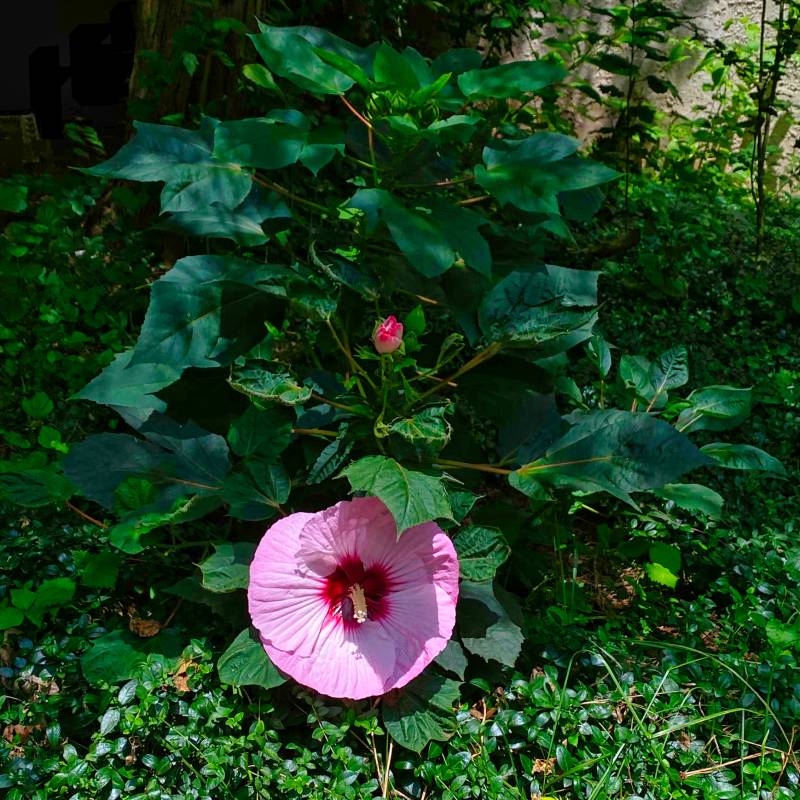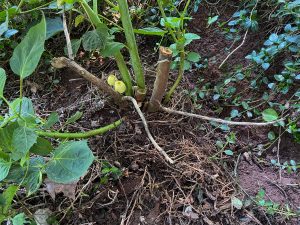
During April of 2019, between trips to various and sundry faraway places, I joined Cathy in a major home improvement effort.
Some of it was inside. This involved renewing my appreciation for professionals in the building trades. Not, unfortunately, by cheering on their renovation of our guest bathroom and shower. But, alas, by confirming that we DIY types need twice as much time and materials to do half as good a job. My work in that bathroom could not exactly be called a surgical strike, but it did lead to one (see below).
Some of the big spring campaign was outside. We finally managed to get a shade-loving ground cover to flourish in what had long been a no-grow zone under our ornamental cherry tree. The flourishing began with planting. Lots and lots of planting of tender young shoots.
The planting outside and the tiling inside required deep knee bends and kneeling. Lots of kneeling and deep knee bends. Far more than required by trained professionals who have learned to economize their movements. Far more, it turned out, than my 67-year old knee could take. (No, that’s not a typo, the other knee was less than 11 years old at that point, and the titanium held up quite well!) By the end of September, the “surgical strike” I mentioned above was required. Now, my knees match, again. (And we maintain a discreet silence about the respective costs of hiring home improvement professionals, versus replacing major body parts.)
But wait, wasn’t this supposed to be about learning the lesson of the hibiscus? What happened to the flower??
Glad you asked! While I was squatting-&-kneeling, squatting-&-kneeling, ad nauseum, ad dolorum, among the lamiastrum galeobdolon variegatum plants, Cathy was busily acquiring other plants that would make our yard more bee, butterfly and hummingbird-friendly. Enter the hibiscus.
When the squatting and kneeling gave way to wincing and limping, Cathy decided I could dig the hole for the new hibiscus plant… later. After the wincing and limping gave way to surgery and rehab, “later” became “much later.” When chilly mornings gave way to frost, and the hibiscus had well and truly shriveled in its plastic pot, she cut the plant back nearly to the roots and put it in the basement.
In April of this year, I thought Cathy was kidding when she asked me to dig a hole and help her plant what looked to me like a hibiscus cadaver. But, being a generous-spirited type, I figured there was no good reason to deny the dead hibiscus a proper Christian burial. So, Cathy’s “planting” was my “burying.”
In the interest of domestic tranquility, and because I wasn’t flying off to remote locations this spring anyway, I also joined in what seemed to me to be the senseless ritual of frequently pouring water over the burial mound. (I swear that 1 Corinthians 15:29 never crossed my mind.)
After days and weeks, to my utter surprise, little shoots began to appear out of the burial mound. A plant grew. And grew. And, at the end of July, flowered. It has been flowering continuously throughout August.
It is a humbling thing for An Ordained Person—a Missionary, no less!—to find himself in the “O ye of little faith” category. Maybe it is not such a bad crowd, since it includes Our Lord’s Apostles. But I also find myself joining in their chorus of, “Lord, increase our faith!” (Luke 17:5).
Increase our faith. O Lord, may it be so! The Slade family hibiscus is tiny in comparison to Ezekiel’s valley of dry bones (Eze. 37). It is infinitesimal in comparison to the thousands of lives and millions of livelihoods lost to COVID-19. It is utterly invisible next to the millions of bodies lacerated by slavery and the tens of millions of lives destroyed or damaged through enslavement, Jim Crow and discrimination.
But the shriveled hibiscus has burst into glorious flower. God called Ezekiel to believe that God’s Spirit could bring the dry bones back to life—and then brought the exiles back to their homeland. Even so, God calls us to believe that new life can spring from the carnage of coronavirus. And even from the centuries-old carnage of enslavement and oppression.
It is easy to feel despair in the face of today’s challenges to the health of our bodies, our households, our society and our world. The problems are massive. And, they will not yield to “quick fixes.” The pandemic feels like it has gone on for years. Even so, and despite the wishful thinking of some, it will continue for months, at least. Slavery and racism have marked us for…. literally, hundreds of years. The on-again, off-again effort to overcome its horrible heritage has already taken over 150 years (over 200, if one sees the 1808 law forbidding the importation of African slaves as the first serious effort to chart a new path for our nation). So, while we must strive for change now, we also have to be in the struggle for the long haul.
Along the way, it is important to keep an eye out for signs of hope. We need to find encouragement on the way, to stay on the way.
So, however humble it may be, from the hibiscus, learn its lesson….
May the Lord surround you with signs of hope and encourage you both to expect and to lean into the coming of God’s Reign, “on earth, as its is in heaven.”
Stan
P.S. I continue to be amazed, humbled by and deeply grateful for the prayers and financial gifts that make this ministry possible—Thank you!!
P.P.S. I also continue to look for encouragement and beauty as I walk through God’s creation outside our backyard! For a glimpse of the photos that emerge from this search, see my page on Facebook or the photo-sharing site Flickr or Unsplash (a place to share photos without restricting their use).
P.P.P.S. Here is a peek behind the leaves of our hibiscus: the cut-off stalks did not re-sprout. The new growth came from the roots and produced new stalks. I think there is another lesson there….
